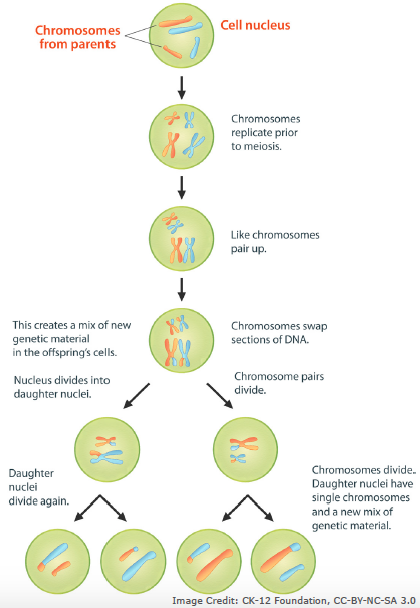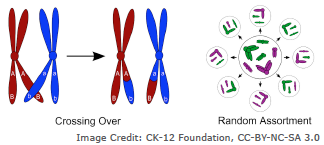Reading: Study Guide
Big Picture
Key Terms
Asexual Reproduction: Reproduction involving a single parent.
Sexual Reproduction: Reproduction involving two parents.
Gamete: Reproductive cells.
Haploid: Cell having only one chromosome of each type.
Diploid: Cell having two of each type of chromosome (twice the amount of chromosomes in haploids).
Fertilization: Process in which two gamete cells unite.
Zygote: A fertilized cell (the result of fertilization).
Meiosis: Cell division where the number of chromosomes is cut in half (results in haploids).
Gametogenesis: Process where haploid cells become gametes.
Crossing-Over: When genetic information is exchanged between homologous chromosomes.
Independent Assortment: When cells divide in meiosis, each individual chromosome is separated randomly and independently.
Asexual Reproduction
Types of asexual reproduction:
• Binary fission: a type of cell division that is also a method of asexual reproduction, where a parent cell splits into 2 identical daughter cells
• Fragmentation: parent cell splits into fragments that become identical daughter cells
• Budding: offspring is attached to the parent like a bud while it grows, then it breaks away once it’s grown
Asexual reproduction allows organisms such as bacteria to reproduce very quickly.
Sexual Reproduction
Sexual reproduction produces unique offspring whose cells contain a mix of chromosomes from the 2 parents
• Parents produce gametes with half the number of chromosomes during meiosis
• Gametes combine to form a zygote during fertilization
• Zygote has the normal number of chromosomes; half from mother, half from father
Meiosis
• Produces haploid gametes; only certain cells in multicellular organisms go through meiosis.
• Meiosis is essentially two cell divisions that produces four haploid cells.
Meiosis I:
• Prophase I: nuclear envelope breaks down; chromosomes condense; centrioles move apart; spindle forms; homologous chromosomes pair up
• Metaphase I: spindle fibers attach to homologous chromosomes; homologous chromosomes line up in pairs along center of the cell
• Anaphase I: homologous chromosomes in each pair separate and move toward opposite ends of the cell
• Telephase: spindles break; nuclear envelopes form around each group of chromosomes
• Cytokinesis: cytoplasm splits, form 2 daughter haploid cells
Meiosis II
(both daughter cells from Meiosis I go through this):
• Prophase II: nuclear envelope breaks down; spindle forms
• Metaphase II: sister chromatids line up along center of cell
• Anaphase II: sister chromatids separate and move toward opposite ends of the cell
• Telephase II: spindles break; nuclear envelopes form around each group of chromosomes
• Cytokinesis: cytoplasm split; four daughter haploid cells are formed
At this point after meiosis, the four haploid cells are NOT gametes yet. The cells develop to become gametes in a process called gametogenesis. Male gametes are called sperms, female gametes are called eggs.

Genetic Variation and Life Cycles
Sexual reproduction results in genetic variation for several reasons:
• Crossing-over: When information is switched between homologous chromosomes in meiosis I; leads to new gene combinations on chromosomes
• Independent assortment: During meiosis, each chromosome separates independently; leads to each daughter cell produced by meiosis to have a unique combination of chromosomes

Life cycle of sexually reproducing organisms:
• General life cycle: diploid adults form gametes, gametes join together to form diploids that continue the same cycle
Sexually reproducing organisms can have different types of lifestyles:
• Haploid life cycle: organisms are gametes for most of their lives; gametes fuse to become diploids that quickly go through meiosis to produce gametes that continue the cycle
• Diploid life cycle: organisms are diploids for most of their lives and produce gametes when they’re ready; gametes join to form diploids that continue the cycle
• Alternation of generations: organisms alternate between generations of being diploids and being haploids.
